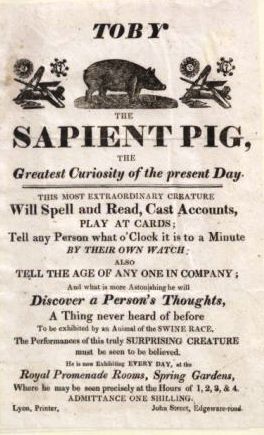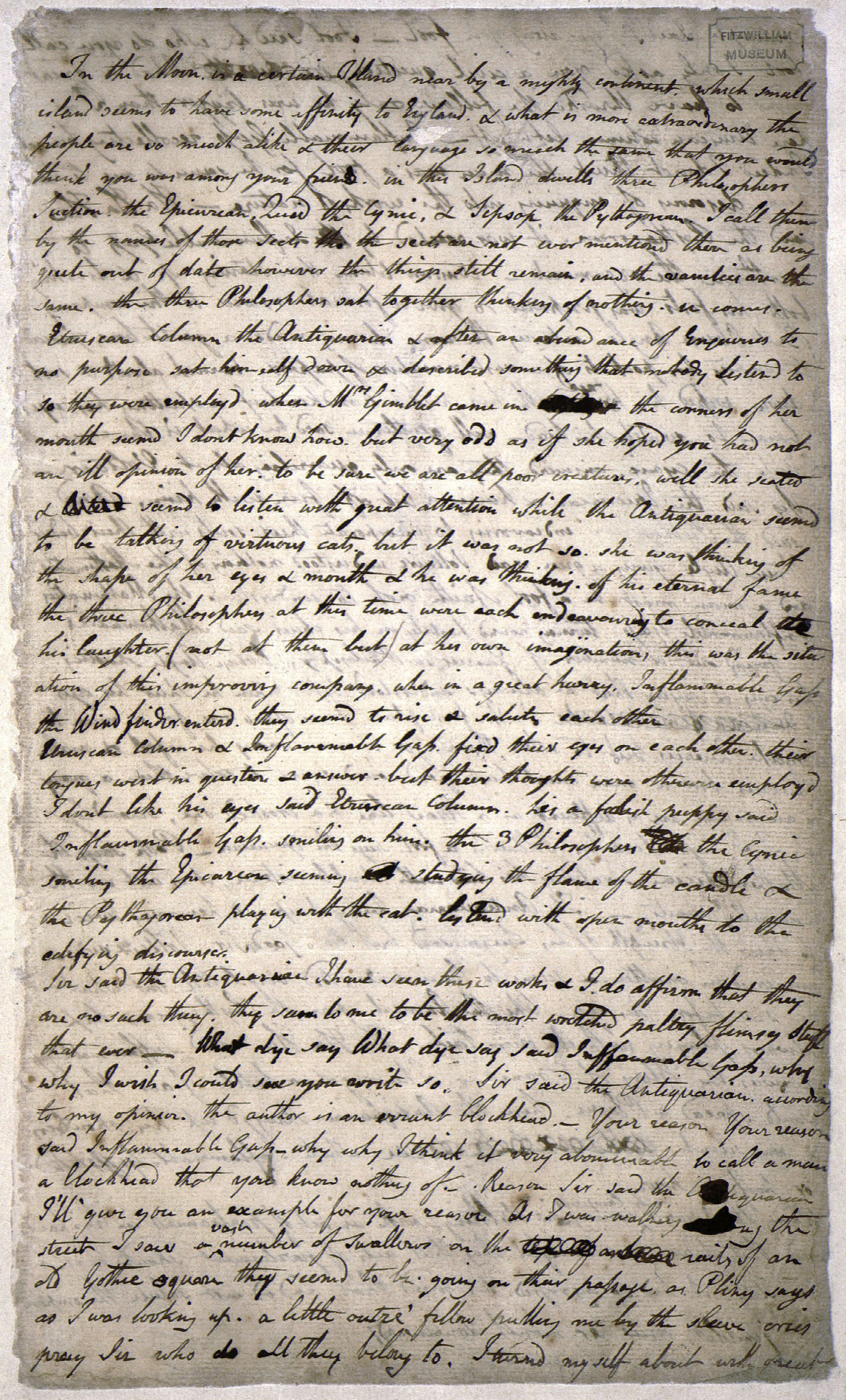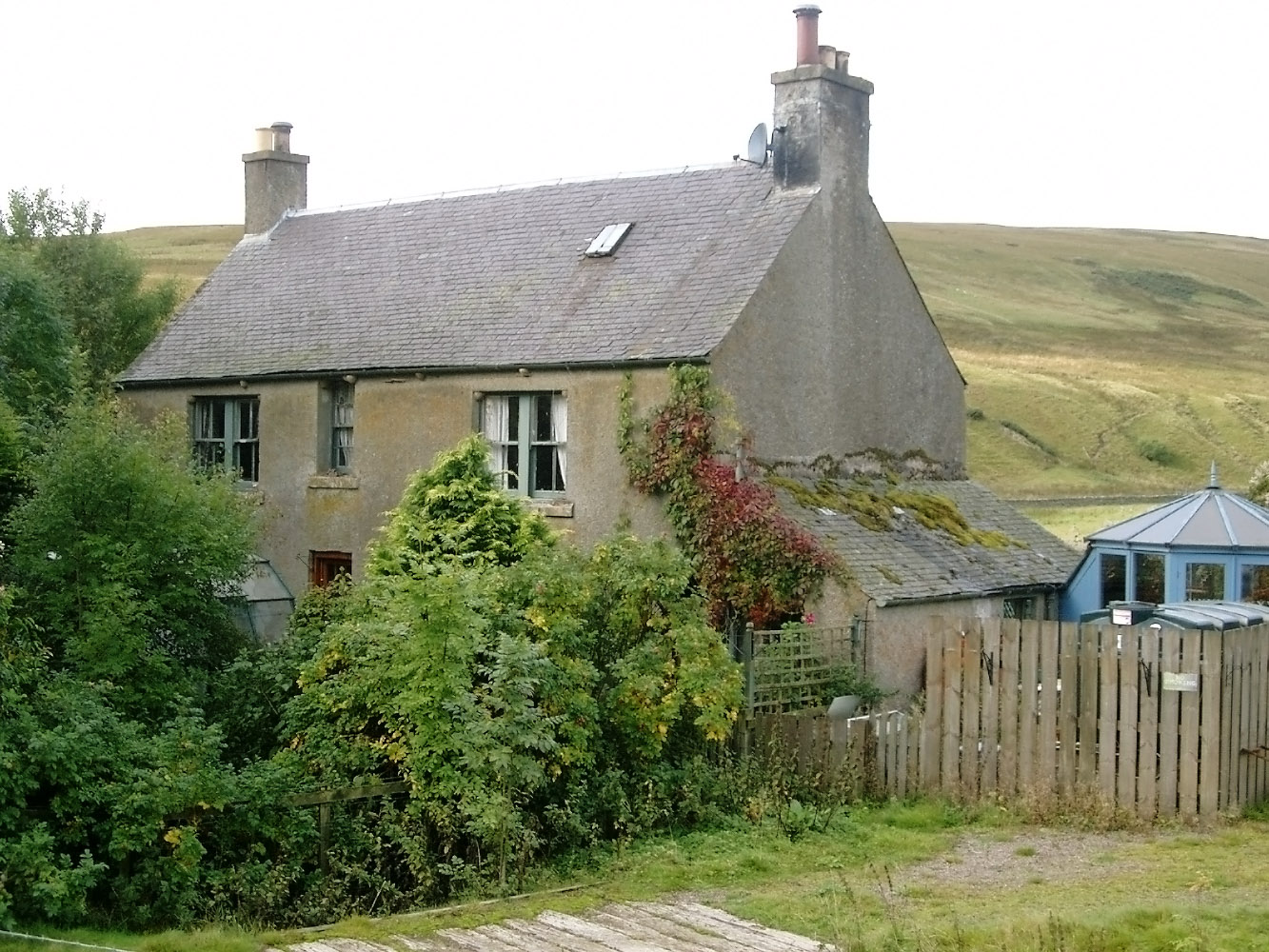|
Learned Pig
The learned pig was a pig taught to respond to commands in such a way that it appeared to be able to answer questions by picking up cards in its mouth. By choosing cards it answered arithmetical problems and spelled out words. The "learned pig" caused a sensation in London during the 1780s. It became a common object of satire, illustrated in caricatures and referred to in literature. The original "learned pig" was followed by other trained pigs, which subsequently became a feature of fairs and other public attractions in Europe and America during the 19th century. In the words of G.E. Bentley, "They served as subjects for cartoons by Rowlandson and moral essays in children's books and savage doggerel by Blake, and they illustrated the manners of the English in works by Joseph Strutt and Robert Southey and Thomas Hood. These freaks of learning clearly exercised a fascination among the literary geniuses of the age as they did among the swinish multitude."G.E. Bentley, "The Freaks of ... [...More Info...] [...Related Items...] OR: [Wikipedia] [Google] [Baidu] |
Thomas Rowlandson
Thomas Rowlandson (; 13 July 175721 April 1827) was an English artist and caricaturist of the Georgian Era, noted for his political satire and social observation. A prolific artist and printmaker, Rowlandson produced both individual social and political satires, as well as large number of illustrations for novels, humorous books, and topographical works. Like other caricaturists of his age such as James Gillray, his caricatures are often robust or bawdy. Rowlandson also produced highly explicit erotica for a private clientele; this was never published publicly at the time and is now only found in a small number of collections. His caricatures included those of people in power such as the Duchess of Devonshire, William Pitt the Younger and Napoleon Bonaparte. Biography Rowlandson was born in Old Jewry, in the City of London. He was baptised on 23 July 1757 at St Mary Colechurch, London to William and Mary Rowlandson. The baptismal record for St Mary, now in the London archi ... [...More Info...] [...Related Items...] OR: [Wikipedia] [Google] [Baidu] |
Story Of The Learned Pig By An Officer Of The Royal Navy 1786
Story or stories may refer to: Common uses * Story, a narrative (an account of imaginary or real people and events) ** Short story, a piece of prose fiction that typically can be read in one sitting * Story (American English), or storey (British English), a floor or level of a building * News story, an event or topic reported by a news organization Social media *Stories (social media), a collection of messages, images or videos, often ephemeral ** Facebook Stories, short user-generated photo or video collections that can be uploaded to the user's Facebook ** Instagram Stories, a feature in Instagram that let the user post vertical images that will disappear in 24 hours ** Snapchat Stories, a feature in Snapchat which allows users to compile snaps into chronological storylines, accessible to all of their friends Film, television and radio * Story Television, an American digital broadcast television network * Story TV, a South Korean television drama production company * ''Stor ... [...More Info...] [...Related Items...] OR: [Wikipedia] [Google] [Baidu] |
Bartholomew Fair
The Bartholomew Fair was one of London's pre-eminent summer charter fairs. A charter for the fair was granted to Rahere by Henry I to fund the Priory of St Bartholomew; and from 1133 to 1855 it took place each year on 24 August within the precincts of the Priory at West Smithfield, outside Aldersgate of the City of London. The fair continued, after the Dissolution within the liberty of the parish of St Bartholomew-the-Great. Description The site of Bartholomew Fair was the south-east side of Smithfield roundabout and was originally a cloth fair. Originally chartered as a three-day event, it would last a full two weeks in the 17th century; but in 1691, it was shortened to only four days. With a change in the calendar, the fair commenced on 3 September from 1753. A trading event for cloth and other goods as well as a pleasure fair, the event drew crowds from all classes of English society. It was customary for the Lord Mayor of London to open the fair on St Bartholomew's Eve. T ... [...More Info...] [...Related Items...] OR: [Wikipedia] [Google] [Baidu] |
The Prelude
''The Prelude or, Growth of a Poet's Mind; An Autobiographical Poem '' is an autobiographical poem in blank verse by the English poet William Wordsworth. Intended as the introduction to the more philosophical poem ''The Recluse,'' which Wordsworth never finished, ''The Prelude'' is an extremely personal work and reveals many details of Wordsworth's life. Wordsworth began ''The Prelude'' in 1798, at the age of 28, and continued to work on it throughout his life. He never gave it a title, but called it the "Poem (title not yet fixed upon) to Coleridge" in his letters to his sister Dorothy Wordsworth. The poem was unknown to the general public until the final version was published three months after Wordsworth's death in 1850. Its present title was given to it by his widow Mary. Versions There are three versions of the poem: * The 1799 ''Prelude'', called the ''Two-Part Prelude'', composed 1798–1799, containing the first two parts of the later poem. * The 1805 ''Prelude'', which w ... [...More Info...] [...Related Items...] OR: [Wikipedia] [Google] [Baidu] |
William Wordsworth
William Wordsworth (7 April 177023 April 1850) was an English Romantic poet who, with Samuel Taylor Coleridge, helped to launch the Romantic Age in English literature with their joint publication ''Lyrical Ballads'' (1798). Wordsworth's ''magnum opus'' is generally considered to be ''The Prelude'', a semi-autobiographical poem of his early years that he revised and expanded a number of times. It was posthumously titled and published by his wife in the year of his death, before which it was generally known as "the poem to Coleridge". Wordsworth was Poet Laureate from 1843 until his death from pleurisy on 23 April 1850. Early life The second of five children born to John Wordsworth and Ann Cookson, William Wordsworth was born on 7 April 1770 in what is now named Wordsworth House in Cockermouth, Cumberland, (now in Cumbria), part of the scenic region in northwestern England known as the Lake District. William's sister, the poet and diarist Dorothy Wordsworth, to whom he wa ... [...More Info...] [...Related Items...] OR: [Wikipedia] [Google] [Baidu] |
Robert Southey
Robert Southey ( or ; 12 August 1774 – 21 March 1843) was an English poet of the Romantic school, and Poet Laureate from 1813 until his death. Like the other Lake Poets, William Wordsworth and Samuel Taylor Coleridge, Southey began as a radical but became steadily more conservative as he gained respect for Britain and its institutions. Other romantics such as Byron accused him of siding with the establishment for money and status. He is remembered especially for the poem "After Blenheim" and the original version of "Goldilocks and the Three Bears". Life Robert Southey was born in Wine Street, Bristol, to Robert Southey and Margaret Hill. He was educated at Westminster School, London (where he was expelled for writing an article in ''The Flagellant'', a magazine he originated,Margaret Drabble ed: ''The Oxford Companion to English Literature'' (6th edition, Oxford, 2000), pp 953-4. attributing the invention of flogging to the Devil), and at Balliol College, Oxford. Southey ... [...More Info...] [...Related Items...] OR: [Wikipedia] [Google] [Baidu] |
An Island In The Moon
''An Island in the Moon'' is the name generally assigned to an untitled, unfinished prose satire by William Blake, written in late 1784. Containing early versions of three poems later included in ''Songs of Innocence'' (1789) and satirising the "contrived and empty productions of the contemporary culture", ''An Island'' demonstrates Blake's increasing dissatisfaction with convention and his developing interest in prophetic modes of expression. Referred to by William Butler Yeats and E. J. Ellis as "Blake's first true symbolic book," it also includes a partial description of Blake's soon-to-be-realised method of illuminated printing. The piece was unpublished during Blake's lifetime, and survives only in a single manuscript copy, residing in the Fitzwilliam Museum, in the University of Cambridge. Background The overriding theory as to the main impetus behind ''An Island'' is that it allegorises Blake's rejection of the bluestocking society of Harriet Mathew, who, along with her ... [...More Info...] [...Related Items...] OR: [Wikipedia] [Google] [Baidu] |
James Barry (painter)
James Barry (11 October 1741 – 22 February 1806) was an Irish painter, best remembered for his six-part series of paintings entitled '' The Progress of Human Culture'' in the Great Room of the Royal Society of Arts in London. Because of his determination to create art according to his own principles rather than those of his patrons, he is also noted for being one of the earliest romantic painters working in Britain, though as an artist few rated him highly until the fully comprehensive 1983 exhibition at the Tate Gallery led to a reassessment of this "notoriously belligerent personality", who emerged as one of the most important Irish artists. He was also notable as a profound influence on William Blake. Life and work James Barry was born in Water Lane (now Seminary Road) on the northside of Cork, Ireland on 11 October 1741. His father had been a builder, and, at one time of his life, a coasting trader between England and Ireland. Barry actually made several voyages as a b ... [...More Info...] [...Related Items...] OR: [Wikipedia] [Google] [Baidu] |
William Blake
William Blake (28 November 1757 – 12 August 1827) was an English poet, painter, and printmaker. Largely unrecognised during his life, Blake is now considered a seminal figure in the history of the poetry and visual art of the Romantic Age. What he called his " prophetic works" were said by 20th-century critic Northrop Frye to form "what is in proportion to its merits the least read body of poetry in the English language". His visual artistry led 21st-century critic Jonathan Jones to proclaim him "far and away the greatest artist Britain has ever produced". In 2002, Blake was placed at number 38 in the BBC's poll of the 100 Greatest Britons. While he lived in London his entire life, except for three years spent in Felpham, he produced a diverse and symbolically rich collection of works, which embraced the imagination as "the body of God" or "human existence itself". Although Blake was considered mad by contemporaries for his idiosyncratic views, he is held in high regard b ... [...More Info...] [...Related Items...] OR: [Wikipedia] [Google] [Baidu] |
James Hogg
James Hogg (1770 – 21 November 1835) was a Scottish poet, novelist and essayist who wrote in both Scots and English. As a young man he worked as a shepherd and farmhand, and was largely self-educated through reading. He was a friend of many of the great writers of his day, including Sir Walter Scott, of whom he later wrote an unauthorised biography. He became widely known as the "Ettrick Shepherd", a nickname under which some of his works were published, and the character name he was given in the widely read series '' Noctes Ambrosianae'', published in ''Blackwood's Magazine''. He is best known today for his novel ''The Private Memoirs and Confessions of a Justified Sinner''. His other works include the long poem '' The Queen's Wake'' (1813), his collection of songs ''Jacobite Relics'' (1819), and his two novels ''The Three Perils of Man'' (1822), and ''The Three Perils of Woman'' (1823). Biography Early life James Hogg was born on a small farm near Ettrick, Selkirkshire, ... [...More Info...] [...Related Items...] OR: [Wikipedia] [Google] [Baidu] |
Thomas Hood
Thomas Hood (23 May 1799 – 3 May 1845) was an English poet, author and humorist, best known for poems such as " The Bridge of Sighs" and "The Song of the Shirt". Hood wrote regularly for ''The London Magazine'', ''Athenaeum'', and ''Punch''. He later published a magazine largely consisting of his own works. Hood, never robust, had lapsed into invalidism by the age of 41 and died at the age of 45. William Michael Rossetti in 1903 called him "the finest English poet" between the generations of Shelley and Tennyson.Rossetti, W. M. Biographical Introduction''The Poetical Works of Thomas Hood'' (London, 1903). Hood was the father of the playwright and humorist Tom Hood (1835–1874) and the children's writer Frances Freeling Broderip (1830–1878). Early life Thomas Hood was born to Thomas Hood and Elizabeth Sands in the Poultry (Cheapside), London, above his father's bookshop. His father's family had been Scottish farmers from the village of Errol near Dundee. The elder Hood ... [...More Info...] [...Related Items...] OR: [Wikipedia] [Google] [Baidu] |
Thomas Tegg
Thomas Tegg (1776–1845) was a British bookseller and publisher. Early life Tegg was the son of a grocer, born at Wimbledon, Surrey, on 4 March 1776, and was left an orphan at the age of five. He was sent to a boarding school at Galashiels in Selkirkshire. In 1785 he was bound apprentice to Alexander Meggett, a bookseller at Dalkeith. He ran away, sold chapbooks at Berwick, and spent time at Newcastle where he met the wood engraver Thomas Bewick. In Sheffield he obtained employment from Joseph Gales, the proprietor of the ''Sheffield Register'', and encountered Tom Paine and Charles Dibdin. Further wanderings took him to Ireland and Wales, and then, after some years at King's Lynn in Norfolk, he moved to London in 1796. London In London he obtained an engagement with William Lane, the proprietor of the Minerva Library, at 53 Leadenhall Street. He subsequently worked for John and Arthur Arch, the Quaker booksellers of Gracechurch Street, where he stayed until he began business o ... [...More Info...] [...Related Items...] OR: [Wikipedia] [Google] [Baidu] |


.jpg)





